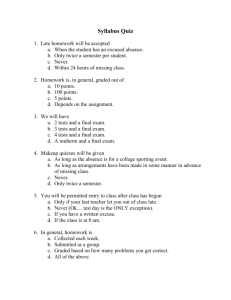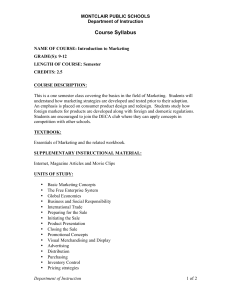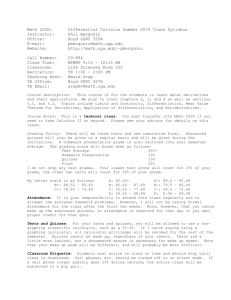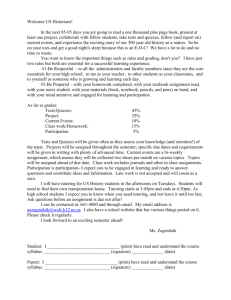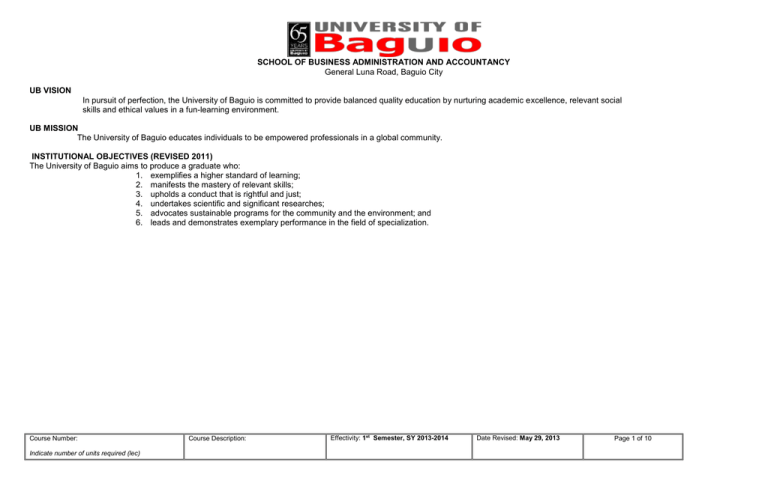
SCHOOL OF BUSINESS ADMINISTRATION AND ACCOUNTANCY
General Luna Road, Baguio City
UB VISION
In pursuit of perfection, the University of Baguio is committed to provide balanced quality education by nurturing academic excellence, relevant social
skills and ethical values in a fun-learning environment.
UB MISSION
The University of Baguio educates individuals to be empowered professionals in a global community.
INSTITUTIONAL OBJECTIVES (REVISED 2011)
The University of Baguio aims to produce a graduate who:
1. exemplifies a higher standard of learning;
2. manifests the mastery of relevant skills;
3. upholds a conduct that is rightful and just;
4. undertakes scientific and significant researches;
5. advocates sustainable programs for the community and the environment; and
6. leads and demonstrates exemplary performance in the field of specialization.
Course Number:
Indicate number of units required (lec)
Course Description:
Effectivity: 1st Semester, SY 2013-2014
Date Revised: May 29, 2013
Page 1 of 10
SCHOOL OF BUSINESS ADMINISTRATION AND ACCOUNTANCY
General Luna Road, Baguio City
SCHOOL MISSION
The School of Business Administration and Accountancy edifies competitive and morally upright individuals.
SCHOOL OBJECTIVES (REVISED 2011)
The School of Business Administration and Accountancy, in an exuberant learning climate, aims to nurture a business graduate who:
1. cultivates the knowledge, that is imperative for career success in a globalized setting;
2. demonstrates relevant skills;
3. utilizes macro-environmental acumen for economic growth and development;
4. typifies professional integrity with humility;
5. undertakes researches to promote systematic bases for business decisions; and
6. models exemplary performance in business.
CORE VALUES
1.
2.
3.
4.
5.
6.
7.
8.
9.
10.
11.
12.
13.
14.
15.
Professional Ethics
Integrity
Objectivity and Independence
Professional Competence and Due Care
Confidentiality
Professional Behavior
Fairness
Transparency
Accountability
Hard Work
Honesty
Patience
Diligence
Innovativeness
Risk-taking
Course Number:
BMKTNG1 (3 UNITS)
Course Description:
Principles of Makerting
Effectivity: 1st Semester, SY 2013-2014
Date Revised: May 29, 2013
Page 2 of 10
1. Program Learning Outcomes (PLO) vis a vis Program Objectives
Program Learning Outcomes
P1
P2
SCHOOL OBJECTIVES
P3
P4
P5
P6
1. Students graduate to become professionals imbued with high moral/ ethical standards
2. Graduates are highly competitive with their acquired knowledge, skills and values in the practice of their profession.
3. Graduates are confident of their academic and industry preparations and the entry competencies learned to tackle the rigors of the
business world.
4. Students can carry out researches that can be utilized in the community and in the business profession.
5. Students recognize their responsibility and accountability as professionals and as workers in the community.
6. Students become aware of and strive for their physical, mental and spiritual well-being.
7. Students are prepared to meet the needs and demands of global employment without losing the Filipino spirit.
8. Students become aware of their responsibility to the environment and participate actively in environmental programs.
2. Course Objectives vis-a-vis Program Learning Outcomes
Course Learning Objectives (CLO)
01
02
PROGRAM LEARNING OUTCOMES
03
04
05
06
07
Cognitive:
C1 Define and explain the principles of marketing
C2 Understand how marketing is related to other business functions and its importance to the success of the business entity
C3 Be able to identify, understand, and apply basic marketing concepts to solving marketing challenges
C4 Understand good marketing practices and techniques and how to apply them
Affective:
C5 Recognize the need to study the principles of marketing
C6 Manifest concern on issues involving marketing
C7 Appreciate the importance of the Ps of marketing to the organization
C8 Cultivate the values of self-discipline, resourcefulness, honesty and integrity
Psychomotor:
C9 Articulate the different concepts and practices in the field of marketing
C10 Design a sound integrated marketing communication plan
C11 Analyze marketing problems and create probable solutions
C12 Research and report on different issues, trends and recent developments in the field of business marketing both in the
Philippines and global setting
Course Number:
BMKTNG1 (3 UNITS)
Course Description:
Principles of Makerting
Effectivity: 1st Semester, SY 2013-2014
Date Revised: May 29, 2013
Page 3 of 10
08
Course Description
The course covers the concepts, theories, principles and practices of Marketing for students to understand marketing and its processes. It also covers important activities and tasks like
analyzing market opportunities, undertaking basic market research and segmenting the market.
Pre-requisite/s: None
Co-requisite/s: None
Course Number:
BMKTNG1 (3 UNITS)
Course Description:
Principles of Makerting
Effectivity: 1st Semester, SY 2013-2014
Date Revised: May 29, 2013
Page 4 of 10
I.
DETAILED COURSE OUTLINE:
Session Learning Objectives/Goals
(SLO/G)
To internalize course content and be
able to know subject requirements
To be able to understand the
meaning of terms essential in
marketing; and realize the
importance and understand the
applications of social responsibility.
To recognize the importance of the
environment to company operations;
and understand the meaning and
relevance of SWOT analysis
To be able to know the meaning of
product and classify consumer
goods and industrial goods
Understand the product life cycle
Course Number:
BMKTNG1 (3 UNITS)
Content Topic
Course Syllabus
VMO
Seat Plan
Leveling of Expectations
Lecture - Discussion
Class interaction
First Grading Coverage
A. Marketing: An Overview
Needs, Wants and Demands
Products
Value, Satisfaction and Quality
Exchange, Transactions and Relationships
Markets
The Marketing Mix
Marketing Management
Social Responsibility Marketing
B. Marketing Environment and SWOT
Analysis
The Microenvironment
The Macroenvironment
The SWOT Analysis
D. Product
Classification of Products
The New Product Development Process
The Product Mix
Product Mix Strategies
Managing Multiple Products and Lines
The Product Life Cycle
Extending the Product Life Cycle
Course Description:
Principles of Makerting
Outcomes Based
Methodologies/Strategies
& Approaches
Learning Outcomes
Time
Allotment
To be able to
prepare materials
for learning and
become
responsible
students
Values
Evaluative
Measures
Professional
Behavior
Recitation
Integrity
Assignment
Quizzes
Recitation
Professional
competence and
due care
Group
dynamics
Case studies
Quizzes
16 hrs
Lecture – Discussion
Interview
Lecture – Discussion
Case studies
Interview
Lecture – Discussion
Case studies
Effectivity: 1st Semester, SY 2013-2014
To be able to
explain the different
core marketing
concepts; and the
marketing
management
philosophies
To distinguish
between the two
types of business
environment, and
which characteristic
form the company’s
strengths,
weaknesses,
opportunities and
threats.
Define the
characteristic of
consumer and
industrial goods
Innovativeness
Determine the
marketing
consideration for
Date Revised: May 29, 2013
Page 5 of 10
Internet/library
research
Quizzes
Group
dynamics
consumer and
industrial goods
Discuss the stages
of product life cycle
First Grading Examination
To differentiate a brand from
trademark; and packaging from
labeling
To understand how internal and
external factors affect price
To understand the price-quality
matrix and determine various pricing
approaches
Define place/distribution, retailing,
wholesaling and be able to identify
aspects that are essential to this
Course Number:
BMKTNG1 (3 UNITS)
Midterm Coverage
Brands and Trademarks
Brand Name vs Brand Mark
Trade Dress
Characteristics of Good Brand Names
Brand Equity
Brand Loyalty
Types of Brands
Packaging
Functions of Packaging
Labeling
E. Price
Price, defined
Price vs. Value
Importance of Price
Pricing Objectives
Factors Affecting the Price Decision
Internal and External Factors
Type of Costs
Price Elasticity of Demand
Effect of Demand Elasticity to Pricing
Decisions
F. Pricing Approaches
New-Product Pricing Strategies
Cost-Based Pricing Strategies
Competition-Based Pricing Strategies
Product-Mix Pricing Strategies
Price-Adjustment Strategies
Psychological, Promotional and Geographical
Pricing
G. Place
Distribution Decisions
Determining Distribution Intensity
Course Description:
Principles of Makerting
2 hrs
Subtotal:
18 hrs
16 hrs
Lecture – Discussion
Oral Presentation
Lecture – Discussion
Reporting
To be able to
discuss the
functions of
packaging and
labeling.
To be able to
compare and
contrast brand and
trademark
Identify and explain
the internal and
external factors to
considered in
devising a
company’s pricing
structure
Professional
competence and
due care
Case analysis
Assignment
Quizzes
Identify the major
consideration in
setting price
Lecture – Discussion
Problem solving
Lecture – Discussion
Case studies
Effectivity: 1st Semester, SY 2013-2014
Identify and define
the different pricing
approaches
Innovativeness
Distinguish
between direct and
indirect marketing
Date Revised: May 29, 2013
Oral
presentation
Quizzes
Assignment
Recitation
Assignment
Internet/library
research
Quizzes
Quizzes
Assignment
Case Analysis
Page 6 of 10
terms
Define promotion and determine its
five elements
Define advertising and identify its
four features
Understand the role of publicity as a
tool of public relations
Define and understand the
characteristics of personal selling.
Course Number:
BMKTNG1 (3 UNITS)
Selection of a Marketing Channel
Functions of Distribution Channels
Benefits Offered by Channel Members
Different Distribution Strategies
The Sales Force
Common Traits of Successful
Salespeople
Retailing
Store Retailing
Non-Store Retailing
Wholesaling
Types of Wholesaling Intermediaries
Midterrn Examination
Finals Coverage
H. Promotion
Marketing Communications, defined
Promotion, defined
Objectives of Promotion
Elements of Promotion
Elements of the Promotional Mix
The Communication Process
Promotional Strategies
I. Advertising and Public Relations
Nature and Scope of Advertising
Types of Advertising
Advertising Strategies
Developing an Advertising Campaign
Defining Objectives
Establishing a Budget
Creating a Message
Selecting Media
Characteristics of the Major Media
Media Scheduling
Public Relations
Publicity
J. Marketing Communication: Personal
Selling, Sales Management and Sales
Promotion
Course Description:
Principles of Makerting
channels;
Discuss the nature
and importance of
marketing
intermediaries
Identify and define
the different types
of store retailing
and non-store
retailing
2 hrs
Subtotal:
18hrs
16 hrs
Lecture – Discussion
Group dynamics
Discuss the
promotional
strategies and
promotional
campaigns
commonly used.
Recitation
Case analysis
Quizzes
Reporting
Determine the
different formats
used in
advertisements
Lecture – Discussion
Case study
Lecture – Discussion
Oral Presentation
Effectivity: 1st Semester, SY 2013-2014
Oral
presentation
Quizzes
Assignment
Library/Internet
research
Discuss how to
develop an
advertising
campaign and a
media strategy
Discuss the two
types of personal
selling.
Date Revised: May 29, 2013
Assignment
Quizzes
Case analysis
Page 7 of 10
To comprehend the two categories
of sales promotion
To recognize the contribution of
internet in marketing.
Examine the impact of e-commerce
to some industry
Personal Selling
Scope of Personal Selling
Classification of Sales Persons
The Creative Selling Process
Sales Management
Sales Promotion
Sales Promotions Geared Towards
Wholesalers and Retailers
Sales Promotions Aimed at Ultimate
Consumers
K. E-Marketing
What is the Internet?
The Users of the Internet
What is e-Commerce?
Why Market Online?
Kinds of Internet Consumers
Selling Overseas
Recitation
Differentiate trade
promotion from
consumer
promotion.
Lecture – Discussion
Case study
Reporting
Analyze the
importance of
internet in
marketing.
Evaluate the
influence of internet
to some consumers
Final Examination
II.
Internet
research
Recitation
Quizzes
Assignment
2 hrs
Subtotal:
18hrs
TOTAL:
54 HRS
GRADING SYSTEM:
For Professional Subjects: the cut-off score is 70%. The highest possible grade is ninety-nine (99); the lowest passing grade is seventy-five (75); and the lowest failing grade is sixty-five
(65).
First grading Highest possible score – 300 points Class standing = 70 % ; Exam = 30 %
Midterms: Highest possible score – 350 points
Class standing = 60 % ; Exam = 40 %
( Tentative Midterm Grade x 2 + First Grading ) / 3 = Midterm Grade
Finals : Highest possible score – 350 points
Class standing = 60 % ; Exam = 40 %
( Tentative Final Grade x 2 + Midterm Grade ) / 3 = Final grade
Course Number:
BMKTNG1 (3 UNITS)
Course Description:
Principles of Makerting
Effectivity: 1st Semester, SY 2013-2014
Date Revised: May 29, 2013
Page 8 of 10
SCHOOL OF BUSINESS ADMINISTRATION AND ACCOUNTANCY
General Luna Road, Baguio City
III.
REFERENCES :
References:
A. Books
Principles of Marketing, Ac-ac, Ma. Victoria M, Anvil Publishing.2009
Strategic marketing Management, Monthino & Sotherns, South-Western CENAGE learning. 2010
Principles of Marketing, Young & Fugoso, REX Book Store. 2008
Marketing Research, Hair/Bush/Ortinau, McGraw-Hill.2009
Global Brand, Post & Post, McGraw-Hill,2008
Global Marketing & Advertising, de Mooiji, Marieke. SAGE. 2010
Principles of Marketing , Kotler & Armstrong, Pearson-Prentice Hall. 2008
Retailing Management, Levy & Weitz, McGraw-Hill. 2012
Introduction to Retailing, Lusch, Dunne & Carver, South-Western. 2011
Professional Salesmanship, Garcia & Villanueva, Bookstore Publishing Corporation. 2009
The New Rules of Marketing, David Meerman Scott, Wiley. 2010
Business-to-Business Marketing, Biemann, Wim G., McGraw-Hill. 2010
B. Electronic Sources
www.knowthis.com/principles of marketing
www.principles of marketing.com
www.businesscasesstudies.co.uk/business theory/marketing
www.marketing principles.com
www.ehow/marketingprinciples
www.free-clep.com/principlesofmarketing
www.pearson.ch.Higfher Education/Marketing/Principles of Marketing
www.waterstones.com/principles of marketing
Course Number:
BMKTNG1 (3 UNITS)
Course Description:
Principles of Makerting
Effectivity: 1st Semester, SY 2013-2014
Date Revised: May 29, 2013
Page 9 of 10
Prepared by:
BA GROUP
Noted by:
MS. ALLYN C. GARIBAY
Assigned Librarian
MS. RUBY R. BUCCAT, MBA
Program Chair
Approved by:
DR. KAREEN B. LEON, CPA
Dean
Course Number:
BMKTNG1 (3 UNITS)
Course Description:
Principles of Makerting
Effectivity: 1st Semester, SY 2013-2014
Date Revised: May 29, 2013
Page 10 of 10

